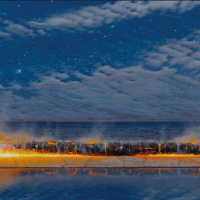26. TIM STORRIER

As one of Australias most significant contemporary artists, Tim Storrier has developed a body of work that is instantly recognisable and universally admired. His outback paintings evoke wondrous feelings of nature and of the Earth as an arena of mysterious rituals, ceremony and elemental surprise. Often featuring glowing embers, leaping pillars of fire and nocturnal skies, these works have placed Storriers work at the pinnacle of Australian art.
Sirrius Flame is a particularly skilful rendition of a fire in the night-sky theme. Painted in 2009, this work shares with other major paintings from the same period a focus on a row of embers arranged in a desert landscape. The blaze is not out of control. Rather, there is a sense that the fire has been carefully orchestrated and lit.
Tim Storriers strong links to the land, in particular his early childhood roots to the family property 'Umagarlee' in the Central West of New South Wales, are important in the development of his art. While Storrier continues to produce work charged with direct and associative references to that place and period since 1970,1 his work since the early 1980s has focused more broadly on the Australian desert and surrounding waterways. Vast tracts of land promote the idea of Australia as an ancient landform composed of primordial natural features and endless space.
In a 1981 trip to Broken Hill, Storrier famously tied a rope between two poles stuck into the ground and set them alight.2 The practice of interacting with nature in this way of recreating primal events to meticulously record them in photographs and paint became a cornerstone of his work and a hallmark of his mature style.
Detailed, ordered and experimental, Tim Storriers consummate paintings of fire in the landscape combine popular perceptions and experiences of the Australian outback with elements of ancient ritual. Performance-based, Storrier sets up situations or events that draw upon and excite our collective imagination. Sirrius Flame distils points of resonance between individual pictorial elements so that they become seamlessly integrated into a uniform whole. The burning stack of embers closely echoes the horizontality of the land and the overhanging canopy of stars. Light illuminates both land and sky and the heat generated by the fire is paralleled by parched and cracked earth.
Fire is central to the Australian story. From the management of the grasses and plains by Indigenous custodians, the wildfires that followed in the wake of European settlement through to the use of fire as a comforting presence for generations of weekend campers, fire has not lost its capacity to be a signifier of both destructive and benign forces.
Fire has also played a central role in Australian art. Tim Storrier continues the tradition of prominent artists including Russell Drysdale (1912-1981), Fred Williams (1927-1982) and Peter Booth (born 1940) who reference fire as either a metaphor for rebirth or the emergence of a nations identity.3 National Gallery of Australia curator Deborah Hart perceptively noted similar sentiments at the time when Storrier first started to exhibit his fire-related works: These paintings are about light, action and stillness. They deal with the real and imagined landscape together with the myth of the outback.4 It is testament to Storriers gift as an artist that one feels central to the action that is unfolding in Sirrius Flame warmed by the embers, captivated by the myriad of reflections and subsumed by the sheer enormity of land and sky.
Footnotes:
1. Artist profile: Tim Storrier, Nanda\Hobbs Gallery, Sydney, http://nandahobbs.com/artist/tim-storrier accessed February 2021.
2. Lumby, C., Tim Storrier: The Art of the Outsider, Craftsman House, Sydney, 2000, p.45.
3. For example see Gavin Wilsons survey exhibition, Fireworks: Tracing the Incendiary in Australian Art, Artspace Mackay, Mackay City Council, 2005.
4. Hart, D., Tim Storrier: Burning Gifts, Australian Galleries, exhibition catalogue, July 1989, p.18.
Rodney James, BA (Hons), MA